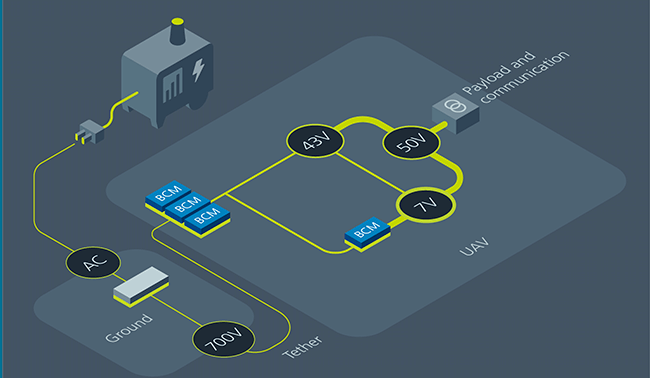Life-saving tethered drones get a power and comms boost
25-03-2022 | By Paul Whytock
The idea of flying a UAV tethered drone system seems incongruous at best, but the fact is that they can do a lot of things better than free-flying drones.
Tethered drones are not a new concept, but their successful application in the past has often been hindered by power and communication shortfalls. This looks set to change with some recent technology breakthroughs.
These types of drones have advantages over free-flying drones when it comes to ease of operation (they don’t need trained pilots), the length of continuous-time they can operate and the fact they are not subject to regulations such as those imposed by the FAA on free-flying drones in relation to aircraft safety.
These characteristics make them ideal for a whole gamut of applications covering anything from military observation, security monitoring, right through to photography and even the boosting of farming efficiencies.
But there is one particular area where they excel: giving first responders in emergency situations an easily implemented tool to provide consistent communications with medical and humanitarian services.
Two critical aspects of providing emergency responders with the in-the-field drones that are actually worth using have been the question of providing them with the power to enable long-term flight and the right communication technology.
Connectivity Breakthrough
A very relevant communications technology breakthrough came during a Virgin Media O2 drone trial conducted in the UK with Swiss tethered drone company Fotokite.
In the first of a series of tests, emergency response teams were able to rapidly launch a tethered drone to a height of 50 metres above a given situation. This meant that on-site emergency personnel could quickly assess the overall emergency scene and communicate with teams based in other locations via a 5G network.
The trial helped develop a greater insight into how 5G connectivity can be employed by emergency services at trauma scenes and remote, hard-to-reach locations.

The tethered Fotokite Sigma system was successfully tested to receive 5G network connectivity from its base station on the ground, to transfer real-time data to first responders at the location and local hospital teams via a smart tablet. The tethered drone also displayed a swift set-up time of two minutes.
Tethered drones are especially helpful for search and rescue missions. A drone is a quick and efficient way to gather information about the scene when tragedy strikes. Drones equipped with radar and thermal sensors give first responders the necessary information to assess the scope of a given disaster and locate trapped survivors.
Tethered drones are being increasingly used in real-time journalism, photography and cinematography. They are cost-effective and easier to deploy than light aircraft or helicopters and are a lot safer in a war zone.
Tethered drones don’t cover large areas, but they can collect data that fixes mapping errors monitor population density and water levels. They are also used to analyse weather patterns, especially tornados and hurricanes.
They can also monitor agricultural crops via near-infrared sensors that will detect the condition of crop health, allowing farmers to make the needed adjustments for the inputs of fertiliser or insecticide to produce better crops. This is a more targeted use of farming chemicals rather than a shotgun blast technique which can be environmentally damaging.
Supplying the Power
All this tethered drone capability is excellent, providing they can stay airborne for long periods, far longer than free-flying drones that have limited flying times.
So the trick here is to keep supplying the drone with the energy it needs to continuously stay airborne, and this is where the tether technology comes into play.
Japanese company Fukaden Corporation has developed a way to provide power for mobile communication base stations designed into its tethered drones. These lightweight, portable drones can be deployed by first responders to quickly deliver communication capabilities once on-site.
In collaboration with major telecommunications carriers in Japan, Fukaden has conducted demonstration tests of its Power Control BOX II Main Power Supply Unit, which delivers power via a tether to the drone. It enables 1kW of power to be delivered up to 150 feet. Also, power can be easily scaled up by using units in parallel to triple the power to 3kW, which provides cellular service to a 10km diameter.
Keep the Cable Light
One of the main failings of tethered drones has been the thickness and weight of the power cable they are connected to. Heavy cables create drag, which requires more power to be pumped through to the drone to keep it airborne and limits the ability to add new features such as sensors or high-resolution video cameras.
Fukaden drones require 1kW to 5kW of power, and increasing the supply voltage from 24V to 370V reduces supply current by a factor of 15, says the company. This means a thinner tether cable can be employed, which reduces the weight of the 1kW tether cable by more than a factor of 10, which reduces weight from 125g to 11.1g per metre.
Getting 370V up to the drone requires a high density, lighter DC-DC converter module to be installed in the drone to step the power down to DC 24V that is needed to drive the motor.
The initial Fukaden high-voltage DC-DC converter design was heavy and consumed too much space. So, the company searched for a small, lightweight DC-DC converter and replaced the large converter with a Vicor DCM (Bus Converter Module) power module.

The Vicor DCM is an isolated DC-DC converter module that uses high-frequency, zero-voltage switching technology and features high conversion efficiency and high output power density. Using the DCM reduced the volume by 75% and cut weight by 50%, says Fukaden.
The company’s next-generation communication drone requires up to 9kW of power. By using higher voltage power (DC 700V), thinner cabling and upgrading to three Vicor BCMs in parallel, Fukaden could scale the power up to 4.5kW. To further scale to nearly 9kW, two Fukaden power supply units can be connected in parallel.
With this added power, the drone can fly for 92 hours and maintain a communication area diameter of 10km, claims the company. The improved performance also helps the base station perform better in difficult weather conditions.

